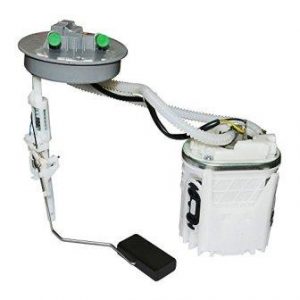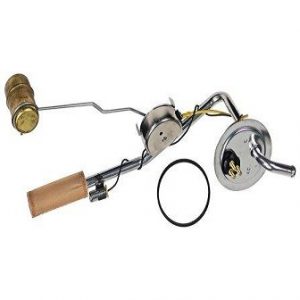

Before we review common fuel tank problems in automobiles let’s talk about what it takes to remove a gas tank from the average vehicle. As a professional automotive mechanic, I have lost count of how many times I’ve had to pull a gas tank out of a truck, car or SUV. Although it’s never fun, the more gas that’s inside, the harder the task becomes.
When we’re talking about correcting common fuel tank problems on an automobile that we own, at least we can control how much fuel remains in the tank when we begin servicing failed auto-parts. Ideally you’ll plan the repairs after running most of the fuel through the engine. In a best case scenario you’ll have less than a quarter of a tank when you begin the removal procedure. However, sometimes these automobiles develop fuel pump problems that don’t allow us this flexibility.
In these cases I recommend siphoning the fuel into an approved storage container. Do yourself a favor and get a quality fluid extractor made for gasoline transfer. An even better solution becomes an electrically powered model that makes quick work of transferring the gas from the automobile to the storage vessel. Finally, the fuel tank is held in by retaining straps with long threaded studs. These undercarriage mounted fasteners see some of the harshest elements. Exposure to road salt and water makes these difficult to remove. Review this article about how to deal with stuck and rusty bolts.
Common Fuel Tank Problems

One of the more frustrating fuel tank problems we can deal with is when the automobile refuses to accept gasoline. Fortunately, we wrote an article dealing with just this problem. See how to diagnose and repair a gas tank that won’t take fuel. Another common fuel tank issue on high mileage vehicles is the failure of the fuel pump.
This specific condition plagues certain automobiles relentlessly. General Motors has its fair share of failed fuel pumps on cars, trucks and sport utility vehicles. You can read this Chevrolet fuel pump technical service bulletin if you’re sure you have this problem.
If you’re not sure why the engine won’t start, but you think it’s the fuel pump, please take the time to diagnose this thoroughly before dropping the fuel tank. Although no starts from a failed fuel pump remain a common problem, other possibilities exist. When it comes to finding out why a vehicle won’t start you can’t beat the step by step diagnostic chart in the Chevrolet repair manual.
The Accuracy of Fuel Level Gauges

Car owners depend on the accuracy of the fuel level information provided by the gas tank mounted sending unit. I’ve owned cars that you could drive around on empty for a couple of days without actually running out of fuel. I’ve also owned vehicles that when the gas gauge hit empty I found myself sitting on the side of the road with a no start.
What people don’t realize is that some manufacturers allow an additional 1 to 5 gallons of reserve fuel to remain in the tank even when the gauge reads empty. With that said, not all manufacturers build this feature into their automobiles. This makes it important for the driver to learn the quirks of their particular automobile in respects to what empty means on their car.
However, despite our understanding of how far the automobile can go on empty, we shouldn’t make a habit out of this. Running the fuel at the bottom of the tank through the engine can prematurely clog the fuel filter. Sand and debris can also find their way throughout the fuel system and cause fuel injector problems. With inaccurate fuel level situations or gas gauges that don’t work at all it’s time to look into the sending unit itself.
The Fuel Tank Sending Unit

On my 1974 Dodge Charger SE the fuel tank sending unit was a thing of simplistic beauty. A brass float connected to a metal arm that operated a variable resistor. This in turn reported accurate information to the analog style fuel gauge on the dash. Believe it or not, most of this basic design theory exists on cars today. With that said, the days of the brass float are long gone. And the variable resistor used to report information to the dash panel also looks quite different. Finally, gauges have switched from analog to digital signals.
In addition, on modern automobiles, you often find the fuel tank sending unit tied together with the fuel pump. They call this a fuel tank module. All the puzzle pieces fit together and then they hang it from the center of the gas tank to do its job. This fuel tank module contains the fuel pump, a nylon filter called a sock, molded fuel lines and the fuel level gauge sending unit. Therefore, when you have fuel tank problems it’s sometimes wise to just replace this entire module.
In some cases you might find the parts available individually. But this means the disassembling and reassembling of the module. When you reinstall this in the tank, with the new sending unit you’re still using an old electric fuel pump. And that fuel system component may not have long to live. As we discussed in the opening, removing the fuel tank is not something you want to do more than once.
Final Thoughts about Fuel Tank Problems
Consider spending a few more dollars and replace the entire fuel tank module. The repairs become more reliable and reduce the risk of you having to perform them sometime in the near future. On many year, make and models purchasing a fuel tank module isn’t much more expensive than purchasing the individual fuel level sending unit. And if you own a 10 year old General Motors vehicle, I can tell you for sure that you want to refresh the fuel pump while you have the tank out of the vehicle.




